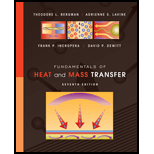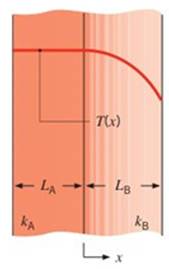
Concept explainers
Consider the steady-state temperature distribution within a composite wall composed of Materials A and B. 
The conduction process is one-dimensional. Within which material does uniform volumetric generation occur? What is the boundary condition at
Want to see the full answer?
Check out a sample textbook solution
Chapter 2 Solutions
Fundamentals of Heat and Mass Transfer
- Heat is generated uniformly in the fuel rod of a nuclear reactor. The rod has a long, hollow cylindrical shape with its inner and outer surfaces at temperatures of TiandTo, respectively. Derive an expression for the temperature distribution.arrow_forward1.63 Liquid oxygen (LOX) for the space shuttle is stored at 90 K prior to launch in a spherical container 4 m in diameter. To reduce the loss of oxygen, the sphere is insulated with superinsulation developed at the U.S. National Institute of Standards and Technology's Cryogenic Division; the superinsulation has an effective thermal conductivity of 0.00012 W/m K. If the outside temperature is on the average and the LOX has a heat of vaporization of 213 J/g, calculate the thickness of insulation required to keep the LOX evaporation rate below 200 g/h.arrow_forwardA hollow aluminum sphere, with an electrical heater in the center, is used in tests to determine the thermal conductivity of insulating materials. The inner and outer radii of the sphere are o.18 and o.21 m, respectively, and testing is done under steady-state conditions with the inner surface of the aluminum maintained at 250°C. In a particular test, a spherical shell of insulation is cast on the outer surface of the sphere to a thickness of o.15 m. The system is in a room for which the air temperature is 20°C and the convection coefficient at the outer surface of the insulation is 30 W/m2. K. If 80 W is dissipated by the heater under steady-state conditions, what is the thermal conductivity of the insulation?arrow_forward
- An important concern in the study of heat transfer is to determine the steady-state temperature distribution of the thin plate when the temperature around the boundary is known. Assume the plate shown in the figure represents the cross section of metal beam with negligible heat flow in the direction perpendicular to the plate. Let denotes the temperature at the four interior nodes of the mesh in the figure. The temperature in the node is approximately equal to the average of the four nearest nodes-to the left, above, to right and below. Write the system of four equations whose solution gives the estimate for the temperature Solve the system for four equations to calculate .T1,T2,T3,T4.arrow_forwardThe wall of a box furnace is made of a composite material. Layer A is directly in contact with the combustion gases inside the furnace and it has a thickness of 0.023 m, a thermal conductivity of 132 W/m-K, and a cross-sectional area of 0.42 m2. On the other hand, Layer C corresponds to the outermost layer that is in direct contact with the ambient air. It has a thickness of 0.036 m, a thermal conductivity of 2 W/m-K, and has the same cross-sectional area as Layer A. In between Layer A and Layer C are two parallel layers: LayerB and Layer D. Layer B has the same cross-sectional area as Layer D. The thickness of Layer B and Layer D is 0.066 m. Layer B has a thermal conductivity of 13 W/m-K; while, Layer D has a thermal conductivity of 23 W/m-K. The combustion gases inside the furnace has a temperature of 373 ; while, the ambient air has a temperature of 30 . Finally, the convection heat transfer coefficients at the inside and outside of the wall are 111 W/m2-K and 22 W/m2-K…arrow_forwardCalculate the heat loss per foot from a 10 in. nominal pipe ( outside diameter = 10.75 in.) covered with a composite pipe insulation consisting of 1 ½ in of insulation A placed next to the pipe and 2 in. of insulation B placed upon insulation A. Assume that the inner and outer surface temperature of the composite insulation are 700°F and 110°F respectively , and that the thermal conductivity of material I is 0.05 Btu/ hr-ft-°F and for material II is 0.039 Btu/hr-ft-°F (Include illustration/Figure)arrow_forward
- A 12 cm thick wall has a thermal diffusivity of 1.5 x 10-6 m2/s and initially a uniform temperature of 85 °C is found. Suddenly the temperature of the outer surface drops to 20 °C while the other is perfectly insulated. Using the finite difference method, with a distance increment of 30 mm and a time increment of 300 s, determine the temperature distribution (T = f(x) ) at 49 minutes. What is the temperature in the middle of the wall at that moment?arrow_forwardAn experiment was conducted to measure thermal conductivity of a formulated food. The measurement was made by using a large plane plate of the food material, which was 5 mm thick. It was found, under steady-state conditions,that when a temperature difference of 35°C was maintained between the two surfaces of the plate, a heat-transfer rate per unit area of 4700 W/m 2 was measured near the center of either surface. Calculate the thermal conductivity of the product, and list two assumptions used in obtaining the result.arrow_forwardA furnace wall consists of 125 mm wide refractory brick and 125 mm wide insulating firebrick separated by an air gap. The outside wall is covered with 12 mm thickness of plaster. The inner surface of the wall is at 1100 and the room temperature is 25. The heat transfer coefficient form outside wall surface to the air in the rooms is 17 W/m2 K, and the resistance to heat flow of the air gap is 0.16 K/W. the thermal conductivities of refractory brick, insulating firebrick, and plaster are 1.6, 0.3 and 0.14 W/m K, respectively. Calculate The rate of heat loss per unit area of wall surface = 1344.88 The temperature at each interface throughout the wall The temperature at the outside surface of the wall Check your answer by calculating outside room Only require help with step 4 i have calculated the rest.arrow_forward
 Principles of Heat Transfer (Activate Learning wi...Mechanical EngineeringISBN:9781305387102Author:Kreith, Frank; Manglik, Raj M.Publisher:Cengage Learning
Principles of Heat Transfer (Activate Learning wi...Mechanical EngineeringISBN:9781305387102Author:Kreith, Frank; Manglik, Raj M.Publisher:Cengage Learning
